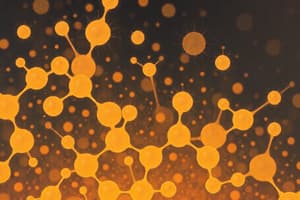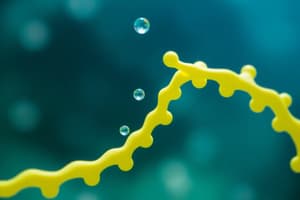Podcast
Questions and Answers
What are carbohydrates that cannot be further decomposed by hydrolysis called?
What are carbohydrates that cannot be further decomposed by hydrolysis called?
Which category of amino acids cannot be synthesized by the human body and must be obtained through diet?
Which category of amino acids cannot be synthesized by the human body and must be obtained through diet?
What type of protein structure is characterized by a specific sequence of amino acids?
What type of protein structure is characterized by a specific sequence of amino acids?
What is the term used for the point at which a protein carries no net electric charge?
What is the term used for the point at which a protein carries no net electric charge?
Signup and view all the answers
Which of the following carbohydrates are known to be sweet in taste?
Which of the following carbohydrates are known to be sweet in taste?
Signup and view all the answers
Which type of carbohydrate upon hydrolysis gives a small, specific number of monosaccharide molecules, typically between 2-10?
Which type of carbohydrate upon hydrolysis gives a small, specific number of monosaccharide molecules, typically between 2-10?
Signup and view all the answers
What is the bond called that links amino acids together in a protein?
What is the bond called that links amino acids together in a protein?
Signup and view all the answers
Which type of carbohydrate is incapable of reducing Tollen’s Reagent and Fehling’s Solution?
Which type of carbohydrate is incapable of reducing Tollen’s Reagent and Fehling’s Solution?
Signup and view all the answers
What term describes a non-protein chemical compound that is tightly and permanently attached to a protein and is essential for its activity?
What term describes a non-protein chemical compound that is tightly and permanently attached to a protein and is essential for its activity?
Signup and view all the answers
Which of the following is a disease associated with the deficiency of the enzyme phenylalanine hydroxylase?
Which of the following is a disease associated with the deficiency of the enzyme phenylalanine hydroxylase?
Signup and view all the answers
Which enzyme is known to have been used to dissolve blood clots?
Which enzyme is known to have been used to dissolve blood clots?
Signup and view all the answers
Which hormone, secreted by the pancreas, is primarily responsible for regulating blood sugar levels?
Which hormone, secreted by the pancreas, is primarily responsible for regulating blood sugar levels?
Signup and view all the answers
What is the basic structural unit of nucleic acids known as?
What is the basic structural unit of nucleic acids known as?
Signup and view all the answers
Which of the following represents a common pyrimidine found in nucleic acids?
Which of the following represents a common pyrimidine found in nucleic acids?
Signup and view all the answers
What is the complementary DNA sequence to the strand with the sequence ATGCTTGA?
What is the complementary DNA sequence to the strand with the sequence ATGCTTGA?
Signup and view all the answers
The sequence of bases on an mRNA molecule synthesized from a DNA strand is determined by what?
The sequence of bases on an mRNA molecule synthesized from a DNA strand is determined by what?
Signup and view all the answers
Study Notes
Carbohydrates
- Carbohydrates are polyhydroxy aldehydes or ketones, or large polymeric molecules that yield polyhydroxy aldehydes and ketones upon hydrolysis.
- Monosaccharides are simple carbohydrates that cannot be further hydrolyzed.
- Common examples of monosaccharides include glucose, fructose, and galactose.
- Disaccharides are carbohydrates that yield two monosaccharide units upon hydrolysis.
- Common examples of disaccharides include sucrose, lactose, and maltose.
- Polysaccharides are carbohydrates that yield a large number of monosaccharide units upon hydrolysis.
- Examples of polysaccharides include starch, cellulose, and glycogen.
- Sugars are carbohydrates that are sweet in taste.
- Non-sugars are carbohydrates that are not sweet in taste.
- Reducing sugars are carbohydrates that reduce Tollen's reagent and Fehling's solution.
- Non-reducing sugars are carbohydrates that do not reduce Tollen's reagent and Fehling's solution.
Proteins
- Amino acids are the basic building units of proteins.
- Amino acids contain both an amino group (-NH2) and a carboxyl group (-COOH).
- Amino acids are classified into three categories: acidic, basic, and neutral.
- Essential amino acids cannot be synthesized by the body and must be obtained from the diet.
- Non-essential amino acids can be synthesized by the body from other amino acids.
- Deficiency of essential amino acids can lead to diseases like Kwashiorkor.
- The isoelectric point is the pH at which an amino acid exists as a zwitterion.
- A peptide bond is formed by the condensation reaction between the carboxyl group of one amino acid and the amino group of another amino acid.
- The N-terminal carbon atom is the first amino acid residue in a polypeptide chain.
- The C-terminal carbon atom is the last amino acid residue in a polypeptide chain.
Fibrous and Globular Proteins
- Fibrous proteins are long, thread-like molecules with a primary structure. They are insoluble in water and provide structural support to tissues.
- Globular proteins are compact, spherical molecules with a complex tertiary structure. They are soluble in water and play a variety of functional roles in the body.
Structure of Proteins
- The primary structure of a protein refers to the linear sequence of amino acids in a polypeptide chain.
- The secondary structure of a protein refers to the local folding of the polypeptide chain, including alpha-helices and beta-sheets.
- The tertiary structure of a protein refers to the overall three-dimensional shape of a single polypeptide chain.
- The quaternary structure of a protein refers to the arrangement of multiple polypeptide chains in a protein complex.
Denaturation of Proteins
- Denaturation is the process that disrupts the secondary, tertiary, and quaternary structures of proteins.
- Denaturation can be caused by various factors, including heat, pH changes, and heavy metal ions.
Prosthetic Groups, Co-enzymes, Co-factors, and Apoenzymes
- Prosthetic groups are non-protein components tightly bound to proteins.
- Coenzymes are organic cofactors that assist enzymes in their catalytic activity.
- Cofactors are non-protein components that are required for the activity of some enzymes.
- Apoenzymes are the protein portion of an enzyme without its cofactor.
Hormones
- Hormones are secreted by ductless glands and regulate the development and activities of cells.
- Phenylketonuria is a genetic disorder caused by the deficiency of the enzyme phenylalanine hydroxylase.
- Another disease caused by an enzyme deficiency is albinism.
- The enzyme streptokinase is used to dissolve blood clots.
- Insulin and growth hormone play significant roles in anabolic systems.
- Insulin is secreted by the pancreas and regulates blood sugar levels.
- Oxytocin causes uterine contractions during childbirth.
- Antidiuretic hormone (ADH) is responsible for controlling water reabsorption in the kidneys.
- Epinephrine and norepinephrine are examples of amine hormones.
Nucleic Acids
- Nucleic acids are biomolecules found in the nuclei of all living cells.
- There are two types of nucleic acids: DNA and RNA.
- DNA stands for Deoxyribonucleic acid.
- RNA stands for Ribonucleic acid.
- A nucleotide is composed of a sugar, a phosphate group, and a nitrogenous base.
- DNA contains deoxyribose sugar, while RNA contains ribose sugar.
- Nitrogenous bases are derivatives of either purine or pyrimidine.
- Purines include adenine (A) and guanine (G).
- Pyrimidines include cytosine (C), thymine (T), and uracil (U).
- DNA contains adenine, guanine, cytosine, and thymine.
- RNA contains adenine, guanine, cytosine, and uracil.
- A nucleoside is a base-sugar unit found in nucleic acid chains.
- AMP stands for adenosine monophosphate.
- dAMP stands for deoxyadenosine monophosphate.
- ATP stands for adenosine triphosphate.
- UDP stands for uridine diphosphate.
Structure of DNA and RNA
- DNA is a double-stranded helix, while RNA is single-stranded.
- DNA nucleotides are linked together by phosphodiester bonds.
- The two strands of DNA are held together by hydrogen bonds between complementary base pairs (A-T, G-C).
Genetic Code and Mutations
- A gene is a sequence of DNA that codes for a specific protein or polypeptide.
- The genetic code is the relationship between the nucleotide triplets (codons) and the corresponding amino acids they encode.
- A mutation is a change in the DNA sequence that can lead to the synthesis of proteins with different amino acid sequences.
- Complementary strands of DNA have opposite base sequences following the base pairing rules (A-T, G-C).
- mRNA (messenger RNA) is synthesized using DNA as a template, and the base sequence is determined by the complementary base pairing rules.
Studying That Suits You
Use AI to generate personalized quizzes and flashcards to suit your learning preferences.
Related Documents
Description
This quiz covers the fundamental concepts of carbohydrates and proteins, including their classifications, examples, and properties. It explores monosaccharides, disaccharides, and polysaccharides, as well as the role of amino acids in protein structure. Test your knowledge on these essential biochemical compounds.



